
Analytical Mass Spectrometry
This technology stream analyses a diverse range of samples. Analytes for study can range from the atomic level to those of moderate molecular weight. Analysis supports the biomedical, environmental, food and beverage, chemical, geological, and pharmaceutical sectors.

Analyses and identifies low molecular weight substances (typ. ≤800Da) found in simple and complex samples.
Technical specifications
- Equipped with a PAL3 multi-technique autosampler for liquids, headspace (HS), and solid-phase microextraction (SPME)
- Several mass spectral libraries available (e.g., NIST, Wiley, Fiehn. Adams Essential Oils)
- Ultra-high efficiency electron ionization ion source
- Mass range of 10 to 1050u
For the elemental analysis of liquid samples originating from a variety of sources.
Technical specifications
- Solution analysis via autosampler
- Speciation analysis (LC-ICP-MS)
- Single-cell and single-particle (nanoparticle) counting (SC-ICP-MS / SP-ICP-MS)
- Removal of polyatomic interferences via ORS4 collision/reaction cell (CRC)
- 11 orders of dynamic range
- Mass range of 1 to 260u
For elemental analysis of liquid or solid samples originating from a variety of sources.
Technical specifications
- Solution analysis via autosampler
- Solids analysis via interfaced laser ablation system (LA-ICP-MS)
- Removal of polyatomic interferences via ORS3 collision/reaction cell (CRC)
- 9 orders of dynamic range
- Mass range of 1 to 260u
Used for the analysis of solid samples in conjunction with an ICP-MS. Common applications include geological, biological, metallurgical, and forensic analysis.
Technical specifications
- 213nm Nd:YAG solid-state UV laser
- 13 spots sizes, 4μm – 250μm
- 1 to 20Hz laser firing (repetition) rate
- Fluence: >25J/cm2 @ sample surface
- 2-volume sample holder
Analyses components in liquid samples.
Technical specifications
- Multiple detectors including fluorescence (FLD), UV-Vis (DAD/PDA), and refractive index (RID)
- Fraction collector to assist in the isolation of select sample components
- Bio-inert flow path
- Flow rates up to 5mL/min (column-dependent)
Provides direct analysis of mercury in liquid and solid samples without pre-treatment or chemical additions.
Common applications include the environmental, food, energy, agriculture, and mining sectors.
Technical specifications
- Quantitative measurements are fast, interference-free, and precise with very little or no memory effect
- Typical working range of 0.003 to 1500ng Hg
- Detection limits of 0.0003ng Hg
Enables fast break-down (digestion) or extraction of solid and liquid samples under closed-vessel conditions.
Common applications include the environmental, biological, food, pharmaceutical, energy, cosmetics, agriculture, and mining sectors.
Technical specifications
- High-throughput and high-pressure rotors/vessels available for both digestion (break-down) and extraction
- Solvent-free microwave extraction of terpenes and essential oils from natural or plant products available
For the break-down (digestion) of sample materials via the open-vessel technique.
Common applications include environmental, biological, food, pharmaceutical, and general chemical analysis.
Technical specifications
- Utilises 50mL digestion tubes
- 48-sample capacity
- Constructed to operate in aggressive/corrosive environments
- Temperature range: ambient to 180°C with 0.2°C stability and 1°C uniformity
Dehydrates frozen sample material via lyophilisation (cryodesiccation).
Common laboratory uses include the freeze-drying of biological samples and other materials for testing.
Technical specifications
- -105°C collector to trap very low melting point solvents
- PTFE (Teflon™) coated collection chamber to resist aggressive vapours
- Multiple types of sample containers available to accommodate different sample sizes/formats
For the concentration/drying of liquid samples under a low-pressure (vacuum) environment.
Common laboratory uses include the concentration/drying of biological and chemical samples.
Technical specifications
- Efficiently evaporates a wide range of solvents used in biological and non-biological processes
- Three fixed-temperature drying settings: ambient, 43°C and 65°C
- Five rotors available to suit different tubes/vessels:
- 1.5/2mL microtubes,
- 2mL autosampler vials,
- 12/13mm tubes,
- 17mm tubes,
- 50mL pear-shaped flasks
- -104°C cold trap to collect (freeze) very low melting point solvents
- PTFE (Teflon™) coated concentrator bowl to resist aggressive vapours
The University of Newcastle acknowledges the traditional custodians of the lands within our footprint areas: Awabakal, Darkinjung, Biripai, Worimi, Wonnarua, and Eora Nations. We also pay respect to the wisdom of our Elders past and present.